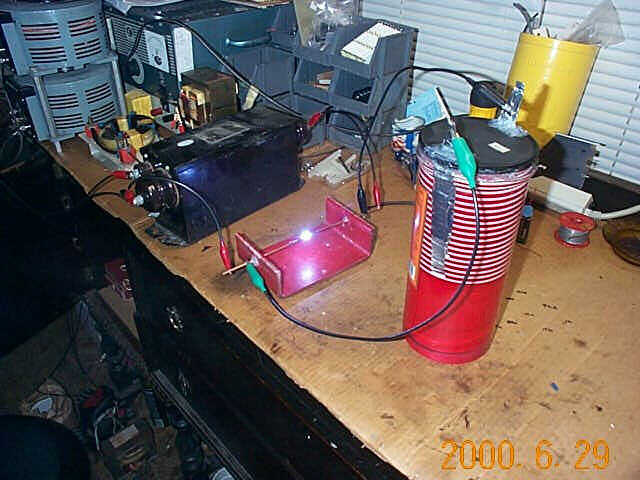
Marc Metlicka's Party Cup Cap
Coiler Marc Metlicka has been experimenting with a novel new homebrew capacitor design based on disposable plastic beverage cups. This idea is very sensible, as plastic cups are often made of very high quality dielectric, such as polystyrene and polyethylene. Watch out for Mylar though! Ugh! Anyhow, I'll let Marc tell you more about his innovative new capacitor in his own words and with his own pictures from our e-mail correspondence. Says Marc:

Here's the pix of the party cup cap. In building this I first started out trying to build it using the knowledge I have gained from my other hawg cap constructions, then I decided to "slap" it together in the quickest, easiest way possible. This way I could test the cap in a "worst" case scenario, sort of a base line scale of endurance. I started by purchasing a stack of party cups at a big lots type store, cost $1.20. I also bought a roll of heavy-duty aluminum foil, cost $1.50. I pulled out about 5" by 18" strip, I rolled it around the cup at about 1" from the top holding the overlap of about 1" tightly, then tearing off the excess. Holding the seam I started rubbing the foil tightly around the cup with the other hand, then folding it under the cup and pressing flat. Then I put the cup inside another cup and putting my hand inside I pressed, squeezed, pushed, twisted, and rubbed the two cups together. When I pulled the cups apart I was surprised at how flat and formfitting the foil had become. I then rubbed the foil even smoother with a sharpie marker, burnishing the bottom folds tightly against the cup. I took the foil cup and pushed it inside the other cup and did the rub, twist, push routine again then pulled them apart one more time, I took the torn off piece and folded it over twice to make the contact strip, I slid it under the foil about 1" then put the cups back together. This made one cell.

I made 10 more cells and put them together alternating the strips side to side, this gave me a double cup dielectric thickness of .035", these cups are styrene so I was guessing a pierce through voltage of 500v per mill. I put the stack together and cut a strip of foil tape and stuck it over all the contact strips to hold them against each other and to hold them flat against the stack. I slid the stack into a beef jerky container (but I think a Tupperware pasta container would seal better) I filled the container with mineral oil, pressing the cups together get most of the air out. I cut two slots in the lid to slide the contact strips through. I then hot glued around the strips, I rolled the cap around to get as much air out as I could. A better container and a vacuum cleaner would help to suck out the air. I let it sit for a day or so, rolling, tapping, squeezing it to get more air out. With ten cells this cap gives me 5 nF, I was surprised at that too.

It took me about an hour to put together at a total cost of $8.70 with a guestimated cost of $4.00 for a better container. The pix show the 15-30 nst's arc without the cap hooked too it and with it connected. I pushed this cap to the max of 17,500v of my nst for about a 15 minute run with no problems, I then hooked it to my 33kv potential trans. and pushed it at full voltage for 15 minutes with the static gap tuned at it's fullest setting that would just barely give a spark, further stressing this cap to the max. It only gave one arc around the top of one cup to the strips then fired fine for the duration. After all this I deemed the "party cup cap" a great success. Since I "slapped" this one together, there is nowhere to go but up with this design. Maybe slide a 20 cell unit inside some 4" PVC, use better cups, foil wrap them better or all of the above. Series them together, parallel them, or whatever. The ultra low cost and good performance gives this design a hearty "thumbs up" in my book, good for the low budget or home built fanatics such as myself. All in all, I wish I would have thought of it sooner, my flat plate caps would have been round.
Marc
That's a pretty cool idea Marc. Thanks for sharing it with us. I hope you'll keep us posted on further development. Perhaps in the near future newbie coilers will be constructing "Metlicka caps" to go along with their Richard Quick gaps and Poolean toroids.
Greg